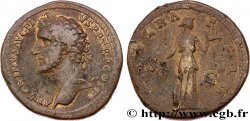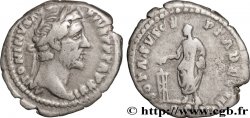v53_0316 - ANTONINUS PIUS Sesterce, (GB, Æ 31)
MONNAIES 53 (2012)
Starting price : 650.00 €
Estimate : 1 200.00 €
Realised price : 650.00 €
Number of bids : 1
Maximum bid : 1 456.00 €
Starting price : 650.00 €
Estimate : 1 200.00 €
Realised price : 650.00 €
Number of bids : 1
Maximum bid : 1 456.00 €
Type : Sesterce, (GB, Æ 31)
Date: 149
Mint name / Town : Roma
Metal : copper
Diameter : 31 mm
Orientation dies : 12 h.
Weight : 24,98 g.
Rarity : R2
Officine: 4e
Coments on the condition:
Exemplaire sur un flan irrégulier et épais, bien centré des deux côtés. Beau portrait de haut relief, bien venu à la frappe. Beau revers de style fin à l’usure régulière avec une faiblesse de frappe sur la légende. Belle patine vert olive clair
Catalogue references :
Obverse
Obverse legend : ANTONINVS AVG - PIVS P P TR P XII.
Obverse description : Tête laurée d'Antonin le Pieux à droite (O*).
Obverse translation : “Antoninus Augustus Pius Pater Patriæ Tribunicia Potestate duodecimum”, (Antonin auguste pieux père de la patrie revêtu de la puissance tribunitienne pour la douzième fois).
Reverse
Reverse legend : TEMPORVM FELICITAS/ S|C// COS IIII.
Reverse description : Deux cornes d’abondance entrecroisées surmontées d’une tête d’enfant affrontées.
Reverse translation : “Temporum Felicitas Consul quartum”, (Les temps de la Félicité consul pour la quatrième fois).
Commentary
Un seul ruban visible. Représentation inhabituelle du revers.
Only one ribbon visible. Unusual representation of the reverse
Only one ribbon visible. Unusual representation of the reverse








 Report a mistake
Report a mistake Print the page
Print the page Share my selection
Share my selection Ask a question
Ask a question Consign / sell
Consign / sell
 Full data
Full data











